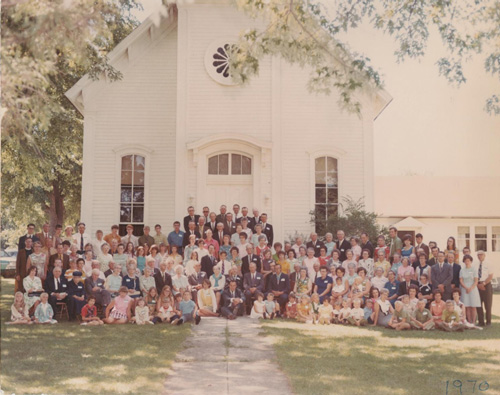The following was written by Elsie Boutelle in her book Oronoco Past and Present which was published in 1983. Permission to use it here was given by her son Richard Boutelle of Rochester, Minnesota. The picture shown here was taken at their 100th anniversary.
First Presbyterian Church of Oronoco, Minnesota – March 1982
Early in 1869, a young minister arrived in Minnesota from New York. After surveying the religious situation in and around Rochester, he placed a notice in the Rochester “Post” announcing that public religious services were to be held in Oronoco each day commencing on Thursday, June 30 and ending on the following Sabbath, July 3, when there would be a public service of worship both morning and afternoon.
This newcomer was the Rev. Thomas Burnet. He was assisted in this venture by the Rev. George Ainslie, minister of the Presbyterian Church in Rochester.
Following the morning service that first Sunday in July, a Sunday School picnic was held, to be followed by the second service. In the bright sunshine of that summer day Mr. Burnet spoke to those gathered this time assisted by Mr. J. A. Leonard, then editor of the Rochester “Post.” Following that afternoon service an important decision was made. There was to be a Presbyterian Church in Oronoco, Minnesota.
Numbers in the church were small from the first. When the church was organized there were only seven members. They were Mr. Leonard Jenne and his wife, Mrs. Martha Holtzman, Mrs. C. Gould, Miss Lovina Gould, Mrs. Anna Gould, and Mrs. Lucy Ann Boutelle.
The congregation was never large in its early years, and the services were supported largely by non-communicant members who felt that it was important that there be a church in the community.
The first trustees of the property were S. R. Terwilliger, L. B. Hodges, and Leonard Jenne, who had contributed substantially to the procurement of the church property, which had been owned by W. C. Buttles and Sarah A. Buttles. These men were elected in October 1870, and the official papers filed with the Court in Rochester.
The first concern of the new congregation was the erecting of a new building suitable as a worship place. By May, 1871 sufficient funds had been gathered for authorization to be given to Nathan Williamson to begin building what was to become a very neat, white wooden structure with a handsome steeple, classroom, and comfortable seating for 130. The building was completed and dedicated in March, 1873, having cost $3,500.00. Because enough funds could not be raised locally, Mr. Burnet went back to New York where the Scotch Presbyterian Church of New York City gave him $1,152. A wooden manse was built beside the sanctuary at the same time. It cost $500. The sanctuary in which worship is conducted today is the original sanctuary, although remodeling and some enlargement has been carried out.
By 1872, the congregation had grown to 15 communicant members, of whom but two were men. The Sunday School had 60 pupils.
The Presbyterian form of government did not become a reality until October, 1873. It was not an easy town in which to minister, yet when Rev. Burnet left in 1880 there were 60 members on the roll. Many different men filled the pulpit after this. In 1890, the Presbyterian Church at Chester reached an agreement with the Oronoco session to jointly support a preacher, and this lasted seven years. Shortly after the turn of the century there followed a long uncertain period in the life of the church. There were no known records of church elders for twenty years. Just before this period a Ladies Aid was formed and these women worked hard to keep the church open. By 1930 it was operating regularly.
Currently the church is yoked with the Zumbrota Congregational Church.
In 1961, the present manse was constructed at a cost of approximately $15,000. Of wooden construction, it has three bedrooms and a full basement. It replaced the old manse which had stood beside the church.
In November of 1902, a new forty-two inch bell was placed in the church tower, to call the people to worship. It is a nice bell and was placed in the church tower, to call the people to worship, and was tuned to the key of C. It chords with the school bell.


![By Jonathunder (Own work) [CC BY-SA 3.0 (http://creativecommons.org/licenses/by-sa/3.0) or GFDL (http://www.gnu.org/copyleft/fdl.html)], via Wikimedia Commons](http://www.oronocoareahistory.org/wp-content/uploads/2017/08/townhallsmall-300x172.jpg)